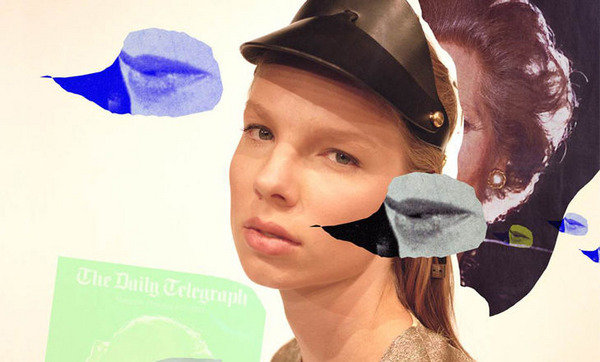11/10/2013
Ursula Mayer
21er Haus, Wien
But we loved her. The artist recombines idea-historical texts and images, developing a multi-layered mesh of autonomous statements and concepts. She worked with Berlin architect Roger Bundschuh to create a cinematographic setting that expands beyond the borders of filmic works, turning objects, sculptures, collages and photographs into an experiential reference and action space.

Curated by Bettina Steinbrügge
But we loved her – the title of Ursula Mayer’s exhibition was taken from a picture in the April 17, 2013 issue of the British daily paper The Independent, the day Margaret Thatcher was interred. The London-based artist collected all the newspaper articles in the days that followed Thatcher’s death, programmatically positioning these four words at the forefront of her exhibition in Vienna, and in a phase of her work that foregrounds questions about the opportunities offers by neoliberal identity, about consumer culture in a post-capitalistic society, and about their precursors.
Based on sources from film, philosophy, politics and culture, Ursula Mayer recombines idea-historical texts and images, developing a multi-layered mesh of autonomous statements and concepts. Her work explores strategies of cinematic image creation which cement social norms so as to expose the structure, alter, and represent exactly these conventional images through the deconstruction of the filmic language. For the 21er Haus, Ursula Mayer worked with Berlin architect Roger Bundschuh to create a cinematographic setting that expands beyond the borders of filmic works, turning objects, sculptures, collages and photographs into an experiential reference and action space.
The point of departure is a trilogy of the films GONDA (2012), MEDEA (2013) and the 16mm double-projected Cinesexual (2013). The central characters, model Valentijn de Hingh and musician JD Samson, who embody versions of such diverse figures move among such diverse figures as Ayn Rand, Medea and Jason, and finally converge with Michael Snow in a a Two Sides to Every Story reference, drawing all the threads together. It is a threshold situation staged to dissolve the oppositions of a binary world-view.
Mayer’s actualization of fundamental social topics spans time from the ancient migration story of Euripides’ Medea to the riots in the Arab world today, and insistently investigates the current conditio humana. It explores questions of individuality and personal freedom, of emotion and the ultimate limit state of human destructivity. The film scripts written by author and art critic Maria Fusco and film theorist Patricia MacCormick are based on original texts source material and pull the viewer into the sensual world of cinematic narrative while catapulting the viewer instantaneously into the individualist present day.
The films are brought into the exhibition space in a tableau vivant of different objects and scenarios, such as the body machines of Bruno Gironcoli. Mayer argues for a performative physicality of film created through elements such as texture, light, and shadow that exists independently of the mere reproduction of the (human) body and functions beyond culturally specific ascriptions. Interpretative sovereignty and the viewpoint of the beholder shift to the foreground. In art signs always communicate possibilities alone – there are no fixed meanings, just individual interpretations. Ursula Mayer initiates a process that calls traditional thought categories into question and so engenders impulses in the future.
Performance on 12 October at 7.30 pm
Transgender model Valentijn de Hingh and musician JD Samson stand at the centre of Ursula Mayer’s live performance of the films GONDA and MEDEA as expressions of our time. Film score: Gediminas Gelgotas. Orchestra: NI&CO (The New Ideas Chamber Orchestra).
Ursula Mayer studied at the Academy of Fine Arts in Vienna and Goldsmiths College in London. She won the Otto Mauer Prize in 2007, and was a scholar in the International Studio & Curatorial Program (ISCP) in New York in 2011. Her films have been presented at international film festivals such as Locarno, Oberhausen and Rotterdam.
Exhibitions, Screenings and Performances (selection): Dairy Art Centre, London; Palais de Tokyo, Paris; Tramway, Glasgow; The Banff Centre, Alberta; Ursula Blickle Stiftung, Kraichtal; Performa 11, New York; Prospectif cinéma, Centre Pompidou, Paris; Kunstverein Hamburg; Institute of Contemporary Arts, London; Whitechapel Gallery, London; Lentos Kunstmuseum Linz; Centraal Museum Utrecht; 11th Baltic Triennial at CAC Vilnius; LUX/ICA Biennial of Moving Images, ICA, London; SculptureCenter, New York; Transmission Gallery, Glasgow; Musée d’art contemporain de Montréal; Bonniers Konsthall, Stockholm; MoMA PS1, New York; Julia Stoschek Foundation, Düsseldorf; Garage, Moscow; Swiss Institute, New York; Kunsthalle Basel; EASTinternational, Norwich; 2nd Athens Biennale; 4th Tirana International Contemporary Art Biennial; Krobath, Berlin; Juliette Jongma, Amsterdam; Monitor, Rome.
The Ursula Mayer exhibition is accompanied by a catalog (English/German) with texts by authors including Diedrich Diederichsen, Maria Fusco, Jutta Koether, Patricia MacCormack, Bettina Steinbrügge and Ian White, designed by APFEL (A Practice for Everyday Life) and published by the 21er Haus (A) and the Ursula Blickle Foundation, Kraichtal (Germany).
Image: Ursula Mayer, Ayn Rand is Margaret Thatcher in Drag, 2013 © Juliette Jongma Gallery, Amsterdam; Monitor, Rome; Krobath, Vienna
Press contact
Dr. Gretchen Simms T +43 (01) 79557275 / g.simms@21erhaus.at
Opening: Saturday, 12 October 2013, 7 pm
21er Haus
Schweizergarten Arsenalstraße 1 1030 Vienna, Austria
Hours: Wednesday–Thursday 11am–9pm;
Friday–Sunday 11am–6pm;
open on public holidays
Admission
Adults € 7
Seniors (60 years and above) € 5.50
Students (0-26 years) € 5.50
Groups (of 10 Persons and over) € 5.50
Children & teenager (0-18 years) free



